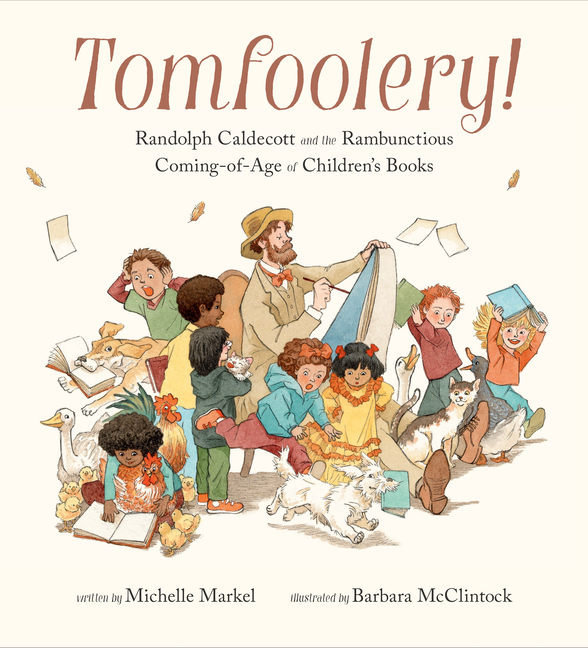
Book Resume
for Tomfoolery!: Randolph Caldecott and the Rambunctious Coming-Of-Age of Children's Books by Michelle Markel and Barbara McClintock
Professional book information and credentials for Tomfoolery!.
7 Professional Reviews (4 Starred)
7 Book Awards
Selected for 1 State/Province List
See full Book Resume
on TeachingBooks
Young readers might not know who Randolph Caldecott is, or even what “tomfoolery” ...read more
- Publisher's Weekly:
- Ages 5 - 8
- Booklist:
- Grades 1 - 5
- School Library Journal:
- Grades 1 - 3
- TeachingBooks:*
- Grades PK-6
- Genre:
- Biography
- Nonfiction
- Picture Book
- Year Published:
- 2023
2 Subject Headings
The following 2 subject headings were determined by the U.S. Library of Congress and the Book Industry Study Group (BISAC) to reveal themes from the content of this book (Tomfoolery!).
7 Full Professional Reviews (4 Starred)
The following unabridged reviews are made available under license from their respective rights holders and publishers. Reviews may be used for educational purposes consistent with the fair use doctrine in your jurisdiction, and may not be reproduced or repurposed without permission from the rights holders.
Note: This section may include reviews for related titles (e.g., same author, series, or related edition).
From Cooperative Children's Book Center (CCBC)
Young readers might not know who Randolph Caldecott is, or even what “tomfoolery” means, but they will easily relate to an artist following his heart and bucking convention, especially an artist who paved the way for creating lively picture books for children. With animated language and ample use of descriptive fonts, the narrator of this picture book biography speaks directly to readers, inviting them back in time to marvel at Caldecott’s journey from invalid to banker to industry-transforming artist. Gorgeous pen and watercolor illustrations match the mood of the text, integrating images from Caldecott’s work as well as original scenes showing his love for animals and action. A full-page recreation of a recognizable literary scene from John Gilpin’s hunt is a masterpiece. This thrilling page-turn celebrates Caldecott’s artistic success and serves as an Easter egg for those familiar with the image on the gold medal bearing his name. Detailed endnotes identify the reproductions of Caldecott’s art referenced, share additional details about the historical events delineated, and provide information about the transformation from Victorian periodicals to “toy books” in this rich history and delightful romp for readers of all ages. (Ages 6-10)
CCBC Choices 2024 © Cooperative Children's Book Center, Univ. of Wisconsin - Madison, 2024. Used with permission.
From Horn Book
January 1, 2024
British illustrator Randolph Caldecott (1846-1886) transformed illustrated books for children ("stiff, full of pretty poses and cluttered scenery") into picture books (ones that featured stories that "tumble�d] forth like life"). Markel briefly covers Caldecott's boyhood, emphasizing his love of drawing and of the outdoors, the latter despite a weak heart. She speaks directly to readers, telling them to move fast ("Quick!") or they'll miss the boy McClintock depicts as racing across the page. As an adult, Caldecott works in a bank but keeps drawing and begins illustrating travel books and, eventually, books for children. Markel emphasizes the artist's ability to capture action on the page and fills this lively text with bustling active verbs (lunging, strutting, pounce4), set off in larger letters and a different font color. Likewise, McClintock's exquisite, energetic illustrations depict Caldecott at the drawing board, creatures bursting forth from his paper. Several instances in the book reproduce the artist's drawings, and one stunning wordless spread showcases the illustration from The Diverting History of John Gilpin that adorns the Caldecott Medal. (The book's abundant back matter includes notes on where Caldecott's art appears in the book.) Children and/or animals appear on nearly every spread of this exuberant tribute to the illustrator who revolutionized children's books.
(Copyright 2024 by The Horn Book, Incorporated, Boston. All rights reserved.)
From Publisher's Weekly
Starred review from September 18, 2023
Randolph Caldecott (1846–1886) was one of the first artists to illustrate children’s books with an eye toward merriment rather than morality, so it’s not surprising that this action-oriented biography by Markel (Out of This World) offers “a hero so chipper he can barely hold still on the paper.” Working in watercolor and pen and ink, McClintock (Vroom!) first shows Caldecott as a bearded young man pulling back an outsize book page to reveal a throng of his drawings come to life. As a boy, Caldecott sketches the animals he loves in motion; as a young man, he confounds his father’s efforts to make him a banker, draws during work hours, and works to improve his skill. Soon, he’s an artist with an offer to illustrate books for children, and “he likes what kids like—action!” Here, reproductions of Caldecott’s own real-life images enter the book as he enjoys his first publishing success. The historical moment of this innovation is captured with verve and verb-forward flourishes in this lively portrait of a person whose illustration style still inspires contemporary picture book creators, some of whose portraits are slipped into a final scene. Characters are presented with various skin tones. Ages 5–8.
From Kirkus
September 15, 2023
The career of one of our most famous picture-book artists comes rip-roaringly to life! Why on earth should kids care about the life of Randolph Caldecott (1846-1886)? Because he brought fun to the picture-book page! From the start, readers are promised "frisky animals, sprightly characters, and a hero so chipper he can barely hold still on the paper." This book is nothing like the children's books of old, which were uninspired, static, and often downright dull. As a child, Caldecott was delighted with animals, sketching them and their movements. He grew up to become a banker and made a living illustrating magazines and newspapers. Given the chance to illustrate a book for children, he filled the pages with what he'd learned. Infused with the sheer energy and joy of the subject matter, McClintock's art pops and bubbles on the page. She deftly interweaves reproductions of Caldecott's own illustrations with her own into a seamless whole, one picture often in play with the next. This is no stodgy biography--Markel's enthusiasm is well matched by McClintock's own (and adults may enjoy identifying the nine illustrators, eight of them, so far, Caldecott Medal winners, gracing one of the book's pages). Markel has crafted a fine companion to her previous bio of John Newbery, Balderdash! (2017), illustrated by Nancy Carpenter. A cacophony of verve and frolic, this is biographical storytelling at its absolute best. (annotations, endnotes, bibliographies) (Picture-book biography. 5-8)
COPYRIGHT(2023) Kirkus Reviews, ALL RIGHTS RESERVED.
From Booklist
Starred review from September 15, 2023
Grades 1-5 *Starred Review* Who was Randolph Caldecott, and why is there an award named for him? Librarians hear that question every year around awards season. From his childhood in the English countryside, where he preferred drawing animals in motion to studying sums, through his young adulthood, when he worked in a bank but developed his skills as an artist, Caldecott's life and artwork are effectively linked. McClintock incorporates reproductions of Caldecott's art into her own visual narrative and includes a key in the back matter to help readers identify which elements are his. Markel's lively, well-documented text functions alongside McClintock's innovative black-ink-and-watercolor compositions and design work by Jennifer Tolo Pierce to give the impression of a book within a book, where real people interact with Caldecott's creations and the time line is both past and present. Details about what makes a great picture book are seamlessly integrated, which could be applied to current Caldecott winners as McClintock also includes portraits of several Caldecott-winning artists. This follow-up to the author's earlier Balderdash! John Newbery and the Boisterous Birth of Children's Books (2017) is another excellent resource, one that explains not only who Randolph Caldecott was but also why his approach to illustrating books for children has had a lasting impact.
COPYRIGHT(2023) Booklist, ALL RIGHTS RESERVED.
From Horn Book
Starred review from September 1, 2023
British illustrator Randolph Caldecott (1846-1886) transformed illustrated books for children ("stiff, full of pretty poses and cluttered scenery") into picture books (ones that featured stories that "tumble[d] forth like life"). Markel briefly covers Caldecott's boyhood, emphasizing his love of drawing and of the outdoors, the latter despite a weak heart. She speaks directly to readers, telling them to move fast ("Quick!") or they'll miss the boy McClintock depicts as racing across the page. As an adult, Caldecott works in a bank but keeps drawing and begins illustrating travel books and, eventually, books for children. Markel emphasizes the artist's ability to capture action on the page and fills this lively text with bustling active verbs (lunging, strutting, pounce), set off in larger letters and a different font color. Likewise, McClintock's exquisite, energetic illustrations depict Caldecott at the drawing board, creatures bursting forth from his paper. Several instances in the book reproduce the artist's drawings, and one stunning wordless spread showcases the illustration from The Diverting History of John Gilpin that adorns the Caldecott Medal. (The book's abundant back matter includes notes on where Caldecott's art appears in the book.) Children and/or animals appear on nearly every spread of this exuberant tribute to the illustrator who revolutionized children's books. Julie Danielson
(Copyright 2023 by The Horn Book, Incorporated, Boston. All rights reserved.)
From School Library Journal
Starred review from July 1, 2023
Gr 1-3-In a history that gallops along like John Gilpin's horse, Markel traces the career of a lad mad for drawing, who switched careers midstream from banking to art and after some low points ("Sometimes, on his letters, he draws himself as a sad, frumpled cartoon") went on to replace the "pretty poses and cluttered scenery" of the Victorian era's picture books with images still notable for their unrestrained energy and humor. McClintock evokes that energy by incorporating samples of Caldecott's art (and, for contrast, examples from stodgier tomes) into her finely drawn views of livestock scurrying underfoot or streaming from sketchbook pages. She also dresses up a busy multiethnic crowd of city and country folk first in period dress, then in modern attire to link past audiences to present ones. In end notes the author fills in some biographical details, with nods to Caldecott's publisher and contemporaries Kate Greenaway and Walter Crane. Readers open to more than just a taste of his distinctive works and sketches of his life and times will find Leonard Marcus's Randolph Caldecott: The Man Who Could Not Stop Drawing well worth the plunge-but this brief tribute gets to the heart of what makes his work so enduringly appealing. VERDICT If Marcus still rules the roost, here's a high-stepping alternative for younger readers.-John Edward Peters
Copyright 2023 School Library Journal, LLC Used with permission.
7 Book Awards & Distinctions
Tomfoolery! was recognized by committees of professional librarians and educators for the following book awards and distinctions.
 ALSC Notable Children's Books, 1995-2025, Commended, 2024
ALSC Notable Children's Books, 1995-2025, Commended, 2024
 CCBC Choices, Selection, 2024
CCBC Choices, Selection, 2024
 Golden Kite Awards, 1974-2024, Nonfiction Text for Young Readers Winner, 2024
Golden Kite Awards, 1974-2024, Nonfiction Text for Young Readers Winner, 2024
 Junior Library Guild Selections, 2012-2025, Arts Selection, 2024
Junior Library Guild Selections, 2012-2025, Arts Selection, 2024
 Horn Book Fanfare, 2001-2024, Selection, 2023
Horn Book Fanfare, 2001-2024, Selection, 2023
 Junior Library Guild Selections, 2012-2025, Arts Selection, 2023
Junior Library Guild Selections, 2012-2025, Arts Selection, 2023
 Publishers Weekly Best Books, 2010-2024, Picture Book Selection, 2023
Publishers Weekly Best Books, 2010-2024, Picture Book Selection, 2023
1 Selection for State & Provincial Recommended Reading Lists
Tomfoolery! was selected by educational and library professionals to be included on the following state/provincial reading lists.
United States Lists (1)
District of Columbia
Preview Digital Book
Explore Tomfoolery! on Marketplace. Access requires OverDrive Marketplace login.
This Book Resume for Tomfoolery! is compiled from TeachingBooks, a library of professional resources about children's and young adult books. This page may be shared for educational purposes and must include copyright information. Reviews are made available under license from their respective rights holders and publishers.
*Grade levels are determined by certified librarians utilizing editorial reviews and additional materials. Relevant age ranges vary depending on the learner, the setting, and the intended purpose of a book.
Retrieved from TeachingBooks on February 02, 2025. © 2001-2025 TeachingBooks.net, LLC. All rights reserved by rights holders.







